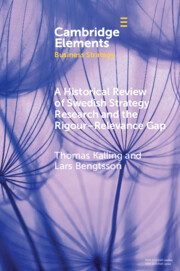Refine search
Actions for selected content:
59 results
Chapter 3 - Relevance
-
- Book:
- Australian Uniform Evidence Law
- Published online:
- 09 December 2025
- Print publication:
- 08 January 2026, pp 114-140
-
- Chapter
- Export citation
12 - Summary, Legacy, and Relevance
-
- Book:
- Before the Fed
- Published online:
- 16 October 2025
- Print publication:
- 30 October 2025, pp 187-204
-
- Chapter
- Export citation
7 - (How) Does Competition Law Address Quality?
-
-
- Book:
- Toward an Inframarginal Revolution
- Published online:
- 26 September 2025
- Print publication:
- 16 October 2025, pp 187-230
-
- Chapter
- Export citation
Chapter 10 - Concluding Remarks
-
-
- Book:
- Leadership in the Ancient World
- Published online:
- 14 September 2025
- Print publication:
- 16 October 2025, pp 223-226
-
- Chapter
- Export citation
Estimation and testing of forecast rationality with many moments
-
- Journal:
- Macroeconomic Dynamics / Volume 29 / 2025
- Published online by Cambridge University Press:
- 08 August 2025, e124
-
- Article
- Export citation
The capacity of ChatGPT-4 for L2 writing assessment: A closer look at accuracy, specificity, and relevance
-
- Journal:
- Annual Review of Applied Linguistics / Volume 45 / March 2025
- Published online by Cambridge University Press:
- 31 July 2025, pp. 253-273
-
- Article
-
- You have access
- Open access
- HTML
- Export citation
Does hearing “and” help children understand “or”? Insights into scales and relevance from the acquisition of disjunction in child Romanian
-
- Journal:
- Journal of Child Language , First View
- Published online by Cambridge University Press:
- 18 July 2025, pp. 1-34
-
- Article
-
- You have access
- Open access
- HTML
- Export citation
TOPICS, NON-UNIFORM SUBSTITUTIONS, AND VARIABLE SHARING
- Part of
-
- Journal:
- The Review of Symbolic Logic , First View
- Published online by Cambridge University Press:
- 10 July 2025, pp. 1-31
-
- Article
-
- You have access
- Open access
- HTML
- Export citation
13 - Evidencing Conversation-Analytic Claims: How Participants Orient to Social Action
- from Part IV - Evidence
-
-
- Book:
- The Cambridge Handbook of Methods in Conversation Analysis
- Published online:
- 06 December 2024
- Print publication:
- 05 December 2024, pp 315-355
-
- Chapter
- Export citation
3 - Knowing the Least About What Matters Most
- from Part I - Science
-
- Book:
- Five Times Faster
- Published online:
- 24 October 2024
- Print publication:
- 07 November 2024, pp 18-30
-
- Chapter
- Export citation

A Historical Review of Swedish Strategy Research and the Rigor-Relevance Gap
-
- Published online:
- 14 March 2024
- Print publication:
- 04 April 2024
-
- Element
- Export citation
5 - Relevance Theory, Non-propositional Content and Ineffability
-
- Book:
- Pragmatics and Emotion
- Published online:
- 13 December 2023
- Print publication:
- 21 December 2023, pp 72-103
-
- Chapter
- Export citation
11 - Supervising Automated Decisions
- from Part III - Synergies and Safeguards
-
-
- Book:
- <i>Money, Power, and AI</i>
- Published online:
- 16 November 2023
- Print publication:
- 30 November 2023, pp 205-220
-
- Chapter
-
- You have access
- Open access
- HTML
- Export citation
2 - Understanding Construction Grammar and Relevance Theory
-
- Book:
- Linguistic Knowledge and Language Use
- Published online:
- 19 October 2023
- Print publication:
- 02 November 2023, pp 5-65
-
- Chapter
-
- You have access
- Open access
- HTML
- Export citation
Mpho le Mphonyana: Two Iterations of Admissibility in Africa
-
- Journal:
- Journal of African Law / Volume 67 / Issue 3 / October 2023
- Published online by Cambridge University Press:
- 26 July 2023, pp. 391-408
- Print publication:
- October 2023
-
- Article
-
- You have access
- Open access
- HTML
- Export citation
15 - Conclusion
- from Part VI - Conclusion
-
- Book:
- Revitalizing the World Trading System
- Published online:
- 22 June 2023
- Print publication:
- 06 July 2023, pp 503-523
-
- Chapter
- Export citation
5 - Know Your Audience
-
- Book:
- How to Talk Language Science with Everybody
- Published online:
- 17 May 2023
- Print publication:
- 29 June 2023, pp 53-65
-
- Chapter
- Export citation
6 - Creating Relevance by Generating Interest
-
- Book:
- How to Talk Language Science with Everybody
- Published online:
- 17 May 2023
- Print publication:
- 29 June 2023, pp 66-79
-
- Chapter
- Export citation
7 - Creating Relevance by Making Connections
-
- Book:
- How to Talk Language Science with Everybody
- Published online:
- 17 May 2023
- Print publication:
- 29 June 2023, pp 80-90
-
- Chapter
- Export citation
3 - Knowing the Least About What Matters Most
- from Part I - Science
-
- Book:
- Five Times Faster
- Published online:
- 19 March 2023
- Print publication:
- 06 April 2023, pp 17-27
-
- Chapter
- Export citation



